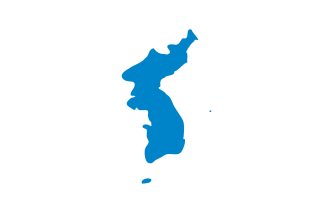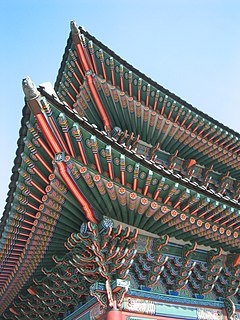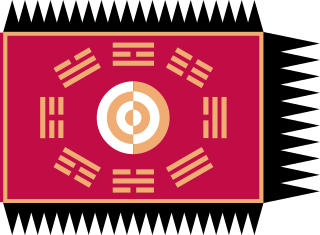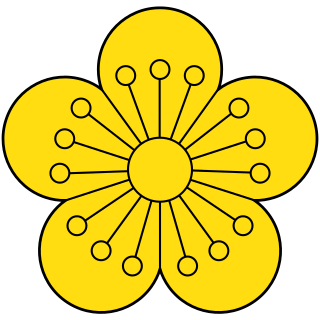
Korea is a region in East Asia. Since 1945, it has been divided between two countries at or near the 38th parallel, North Korea and South Korea. Korea consists of the Korean Peninsula, Jeju Island, and several minor islands near the peninsula. It is bordered by China to the northwest and Russia to the northeast. It is separated from Japan to the east by the Korea Strait and the Sea of Japan.
This is a list of articles on Korea-related people, places, things, and concepts. For help on how to use this list, see the introduction below.

The music of Korea refers to music from the Korean peninsula ranging from prehistoric times to the division of Korea into South and North in 1945. It includes court music, folk music, poetic songs, and religious music used in shamanistic and Buddhist traditions. Together, traditional Korean music is referred to as gugak, which literally means "national music."

The traditional culture of Korea before the division of Korea in 1945 is the shared cultural and historical heritage of Korea and southern Manchuria. As one of the oldest continuous cultures in the world, Koreans have passed down their traditional narratives in a variety of ways. Since the mid-20th century, Korea has been split between the North Korean and South Korean states, resulting today in a number of cultural differences. Before the Joseon dynasty, the practice of Korean shamanism was deeply rooted in Korean culture.

Joseon was a Korean dynastic kingdom that lasted for over five centuries. It was the last dynastic kingdom of Korea. It was founded by Yi Seong-gye in July 1392 and replaced by the Korean Empire in October 1897. The kingdom was founded following the aftermath of the overthrow of Goryeo in what is today the city of Kaesong. Early on, Korea was retitled and the capital was relocated to modern-day Seoul. The kingdom's northernmost borders were expanded to the natural boundaries at the rivers of Amnok and Tuman through the subjugation of the Jurchens.

Gojoseon was the first Korean kingdom that lasted until 108 BCE. According to the legend of the kingdom, the kingdom was established by the founder named Dangun. Gojoseon possessed the most advanced culture in the Korean peninsula at the time and was an important marker in the progression towards the more centralized states of later periods. The addition of Go, meaning "ancient", is used to distinguish the kingdom from the Joseon dynasty that emerged later in 1392 CE.

Lee, I, or Yi is the second-most-common surname in Korea, behind Kim (Gim). Historically, 李 was officially written as Ni in Korea. The spelling officially changed to I in 1933 when the initial sound rule was established. In North Korea, it is romanized as Ri because there is no distinction between the alveolar liquids /l/ and /r/ in modern Korean. As of the South Korean census of 2015, there were 7,306,828 people by this name in South Korea or 14.7% of the population.
Kim or Gim is the most common surname in Korea. As of the South Korean census of 2015, there were 10,689,959 people by this name in South Korea or 21.5% of the population. Kim is written as 김 (gim) in both North and South Korea. The hanja for Kim, 金 can also be transliterated as 금 (geum) which means "metal, iron, gold". The academic community is divided as to why 金 is not read as 금 in the case of surname and why it is read as 김 instead. The Kim family is also the ruling family in North Korea.

The Later Jin invasion of Joseon occurred in early 1627 when the Later Jin prince Amin led an invasion of the Joseon dynasty. The war ended after three months with the Later Jin establishing itself as sovereign tributary overlord over Joseon. However Joseon continued its relationship with the Ming dynasty and showed defiance in solidifying its tributary relationship with the Later Jin. It was followed by the Qing invasion of Joseon in 1636.

The Qing invasion of Joseon occurred in the winter of 1636 when the newly established Qing dynasty invaded the Joseon dynasty, establishing its status as the center of the Imperial Chinese Tributary System and formally severing Joseon's relationship with the Ming dynasty. The invasion was preceded by the Later Jin invasion of Joseon in 1627.
Hyangak, literally "indigenous/native music, folks music" is a traditional form of Korean court music with origins in the Three Kingdoms period. It is often accompanied by traditional folk dances of Korea, known as hyangak jeongjae. These dances are performed in front of audiences—as opposed to the square dance more familiar to Westerners, which is primarily for the participants' enjoyment.

The Korea Football Association is the governing body of football in South Korea.

Korean ceramic history begins with the oldest earthenware from around 8000 BC. Throughout the history, the Korean peninsula has been home to lively, innovative, and sophisticated art making. Long period of stability have allowed for the establishment of spiritual traditions, and artisan technologies specific to the region. Korean ceramics in Neolithic period have a unique geometric patterns of sunshine, or it's decorated with twists. In Southern part of Korea, Mumun pottery were popular. Mumun togi used specific minerals to make colors of red and black. Korean pottery developed a distinct style of its own, with its own shapes, such as the moon jar or Buncheong sagi which is a new form between earthenware and porcelain, white clay inlay celadon of Goryeo, and later styles like minimalism that represents Korean Joseon philosophers' idea. A lot of talented Korean potters were captured to Japan after the porcelain war in 1592–1598. Arita ware, founded by Yi Sam-pyeong opened a new era of porcelain in Japan. Another Japanese representative porcelain, Satsuma ware was also founded by Dang-gil Shim and Pyeong-ui Park. 14th generation of Su-kwan Shim have been using the same name to his grandfather and father to honor they are originally Korean, 14th Su-kwan Shim is honorable citizen of Namwon, Korea.

The House of Yi, also called the Yi dynasty, was the royal family of the Joseon dynasty and later the imperial family of the Korean Empire, descended from the Joseon founder Yi Seong-gye. All of his descendants are members of the Jeonju Yi clan.

Kisaeng, also called ginyeo, were women from outcast or slave families who were trained to be courtesans, providing artistic entertainment and conversation to men of upper class. First appearing in Goryeo, kisaeng were the government's legal entertainers, required to perform various functions for the state. Many were employed at court, but they were also spread throughout the country. They were carefully trained and frequently accomplished in the fine arts, poetry, and prose, and although they were of low social class, they were respected as educated artists. Aside from entertainment, their roles included medical care and needlework.

The haegeum (Korean: 해금) is a traditional Korean string instrument, resembling a vertical fiddle with two strings; derived from the ancient Chinese xiqin. It has a rodlike neck, a hollow wooden soundbox, and two silk strings, and is held vertically on the knee of the performer and played with a bow. It is also popularly known as kkangkkang-i (깡깡이), kkaengkkaeng-i (깽깽이), or aeng-geum (앵금).
This is a partial index of Korea-related articles beginning with S.

Jongmyo is a Confucian shrine dedicated to the perpetuation of memorial services for the deceased kings and queens of the Korean Joseon Dynasty (1392–1897). According to UNESCO, the shrine is the oldest royal Confucian shrine preserved and the ritual ceremonies continue a tradition established in the 14th century. Such shrines existed during the Three Kingdoms of Korea period (57–668), but these have not survived. The Jongmyo Shrine was added to the UNESCO World Heritage list in 1995.

Jongmyo Jerye or Jongmyo Daeje is a rite held for worshipping the late kings and queens of the Joseon Dynasty in Jongmyo Shrine, Seoul, South Korea. It is held every year on the first Sunday of May. The Jongmyo rite is usually accompanied with the court music playing (Jerye-ak) and dance called Ilmu or line Dance. Jongmyo Jerye and Jeryeak were designated as the first of South Korea's Masterpieces of the Oral and Intangible Heritage of Humanity by UNESCO in 2001.
Jeong-dong is a legal dong, or neighbourhood of the Jung-gu district in Seoul, South Korea and governed by its administrative dong, Sogong-dong.














